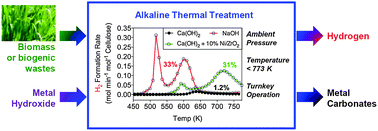Biomass conversion to H2 with substantially suppressed CO2 formation in the presence of Group I & Group II hydroxides and a Ni/ZrO2 catalyst
Abstract
The production of H2 with substantially suppressed CO2 formation is achieved using Group I and II hydroxides in the alkaline thermal treatment of cellulose. Although strong hydroxides (e.g., NaOH) have shown greater conversion to H2 with minimal gaseous byproducts, similar performance is also achieved with Ca(OH)2, using a Ni/ZrO2 catalyst.


 Please wait while we load your content...
Please wait while we load your content...